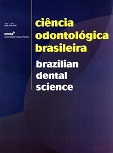Avaliação do sistema de retenção barra/clipe em prótese mucossuportada e implantorretida utilizando o método dos elementos finitos
DOI:
https://doi.org/10.14295/bds.2009.v12i1.259Abstract
O processo de reabsorção óssea na crista do rebordo, ao redor dos implantes, é uma ocorrência clínica aceita pela comunidade científica, porém, o fator causal ainda não está totalmente elucidado. Dentre os processos mais aceitos está a indução por bactérias e a sobrecarga oclusal. O objetivo deste trabalho é avaliar comparativamente o gradiente de tensões dissipadas no osso, nas proximidades de dois implantes interligados por uma barra tipo Dolder, em um sistema de prótese mandibular mucossuportada e implantorretida por clipe. O intuito é saber qual disposição de clipes de 7 mm (Conexão Sistemas de Prótese, SP, Brasil) e 5 mm (Lifecore Biomedical Chasca, MN, USA) de comprimento, entre cinco analisadas, proporciona os menores níveis de tensão na região periimplantar. Foram desenvolvidos cinco modelos 3D em elementos finitos, simulando diferentes disposições dos clipes ao longo da barra. A força aplicada foi de 100N, na direção axial dos implantes. Para a análise qualitativa todas as situações estudadas apresentaram padrão semelhante na distribuição de tensões, com maior incidência das tensões compressivas nas faces distais aos implantes. Avaliando quantitativamente as tensões de Von Mises nas diferentes configurações, pode-se verificar que dois clipes dispostos mais próximos dos implantes produziram melhores resultados, sendo que os dois clipes de 5 mm, os que mostraram melhor desempenho.Downloads
Downloads
Published
How to Cite
Issue
Section
License
Brazilian Dental Science uses the Creative Commons (CC-BY 4.0) license, thus preserving the integrity of articles in an open access environment. The journal allows the author to retain publishing rights without restrictions.
=================




























